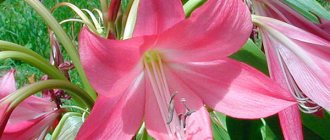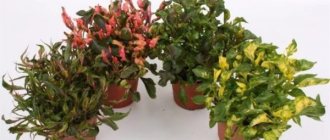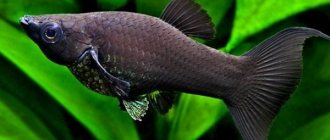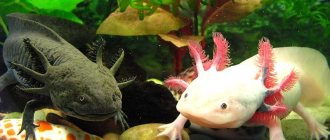Crinum undulata is a fairly well-known freshwater plant, especially among those who are interested in the aquarium hobby, and belongs to the amaryllis family. It was brought from western Africa. In the wild, this plant is an inhabitant of periodically drying up reservoirs, so it can be outdoors for some time.
Crinum wavy is a fairly small representative of this species, but even this does not make its size less impressive. The length of the leaves can reach 120 cm, which should not frighten owners of small aquariums; crinum tolerates haircuts well.
Description
Crinum is a plant of the Amaryllis family that can exist both in water and on land. It adapts perfectly to any conditions, so it is found on all continents except Antarctica. Some species grow on mountain slopes, at an altitude of more than 1000 m, but most of them still live under water.
Crinum is characterized by dense, long and narrow leaves, reaching 2 meters, a thick stem and strong roots. Aquarists believe that crinum flowers are the most beautiful of all similar plants. A shoot with several flowers comes to the surface of the water. Flowers can have different colors, depending on the species. This crop can bloom from 1 week to one and a half months.
Unpretentiousness and longevity are the main reasons why it has gained popularity among experienced aquarium plant lovers from all over the world.
Krinum
All about crinums in the aquarium
Krinum (lat. Crinum) is a genus of bulbous plants of the Amaryllidaceae family. Perennial herbaceous plants. Crinum differs from other amaryllis primarily in its large size, although there are also small plants among the representatives of the genus.
Crinum bulb with long or short neck. Many species form a false trunk from the base of the leaves, ending in a fan of leaf blades.
The leaves are numerous, long - up to 1 m, linear-lanceolate, belt-shaped. Unlike other amaryllis, the young leaves of crinums are not flat, but rolled into a tube.
The genus Krinum includes more than 10 species. Some of them are suitable for keeping in aquariums and ponds - these are, first of all:
Crinum calamistratum - leaves up to 2 meters.
— Crinum natans with floating leaves up to 1 meter long.
— Crinum purpurascens, the leaves of which are more modest in size - up to 30 cm.
— Thai crinum (Crinum thaianum), they are grown at low water levels in a pot with clay soil.
Keeping crinums in the aquarium
Krinum in the aquarium photo
Crinum can only be kept in a large aquarium. Lying like a serpentine on the surface of the water, crinum leaves can cover the entire surface of the aquarium, shading other plants. It is usually planted at the back or side walls of the aquarium.
Water parameters for keeping crinum: the plant should be grown in a tropical aquarium at a water temperature of 23℃. In colder water, growth slows down significantly, the plant begins to shed old leaves and degrade. The water can be soft and a little hard. It should be taken into account that at hardness levels below 4℃, growth may be unstable. The active reaction should be neutral or slightly alkaline, pH 6.5-8. In slightly acidic water, the old leaves of the plant are destroyed very quickly. The water should be clean, without excess nitrogenous compounds, 1/4 of its volume should be regularly changed once a week. Lighting can be moderate or strong 50-100+ Lm/l. The long leaves of crinum rise to the surface and are located in close proximity to the light source, so the plant receives enough light even from a relatively weak source. The duration of daylight should be at least 8-12 hours (depending on the light intensity and other conditions).
The substrate for crinum should contain a large amount of organic matter. When planting in new soil, it is advisable to place a substrate or fertilizer tablets, such as Tetra Crypto, under the roots of crinum. Medium fraction soil and sand can be used as a substrate. The thickness of the soil layer when planting a young plant can be about 5 cm. As the plant develops, soil can be added, increasing its layer to 10 cm.
There is no need to add liquid fertilizers to the aquarium water, since the plant receives its main nutrition through the soil and roots.
Krinum reproduces in an aquarium only vegetatively, forming daughter bulbs in close proximity to the mother plant. This process is quite long. From the moment a young plant is planted until its first children appear, even under the best conditions, at least 3 years pass.
At high temperatures, low water levels and bright sunlight, it is possible to achieve flowering of crinum, but it has not yet been possible to obtain full-fledged seeds in aquarium conditions.
Types of crinums that are grown in aquariums
Crinum wavy or curly in the aquarium
Crinum wavy in an aquarium photo
Crinum calamistratum is a plant with an elongated bulb, 1-3 cm thick, up to 10 cm long. The leaves are collected in a rosette, ribbon-shaped, somewhat twisted, 70–200 centimeters long, 0.2–0.7 centimeters wide, dark green, the leaf edge is wavy. Clear central vein. Peduncle up to 80 cm long, straight. An inflorescence up to 80 cm long with 1–3 fragrant flowers. Bract about 3.5 cm long. Flowers with a straight green tube near the flower bed, 10–12 cm long, in white, backward inclined, 6–7 cm long and 0.5–0.8 cm wide tepals (lobes) as well as 6 stamens. The pistil is about 7 cm long.
Crinum wavy in an aquarium photo
Wavy crinum with strongly is a very attractive bulbous plant. This is not a very demanding plant: soft to medium hard water with a pH of 7 is recommended. The soil should be nutritious and at least 8 centimeters high. Strong water flow promotes plant growth. Medium intensity lighting is sufficient. Crinum wavy grows much slower than other species, so you will have to wait several months before a good specimen grows from the sprout.
Transplantation has a negative effect on crinum wavy. The plant is intended for keeping in aquariums with a water column height of 50 centimeters.
Crinum swimming in an aquarium
Crinum swimming in an aquarium photo
Crinum natans Baker is native to West Africa from Guinea to Cameroon and south to Zaire. The species grows in forested tropical streams and rivers with very fast currents, also in direct sunlight, in pebbly and rocky or muddy soil.
A large, strongly plant with an almost round bulb, up to 5 cm thick. The leaves are in a rosette, ribbon-shaped, dark green, up to 150 cm long and up to 5 cm wide, usually very curly, rarely almost flat, the leaf edge is irregularly corrugated.
Crinum swimming in an aquarium photo
This is a very large decorative type of crinum. For cultivation, a large aquarium is required so that the ribbon-like leaves can spread along the surface of the water. In an aquarium, crinum floating develops well in soft to medium-hard water and pH 7. The substrate, in accordance with the size of the bulb, must be at least 10 cm high and nutritious. Since plants prefer places with fast currents, you should make sure that there is good water flow in the aquarium. Crinum aquatic sometimes reproduces vegetatively by daughter bulbs on large mother plants. With artificial pollination, seeds are set. The seeds germinate well and the young plants grow quickly, reaching a height of about 15 cm after about 10 weeks. There are forms with more or less tightly curled leaves.
Crinum purpurea in the aquarium
Crinum purpurea in an aquarium photo
Crinum purple photo
Crinum purpurascens - grows naturally on the banks of ponds and rivers in Guinea. The bulb is ovoid, small, 5 cm in diameter, easily forms babies. Leaves are 30 cm long. Peduncle 30 cm long, with 5-9 flowers in an umbrella, petals 6-7 cm, purple, red. Cultivated in warm paludariums, planted in ponds in which they are planted in a semi-submerged state.
Crinum thailandica in an aquarium
Crinum thailandica in an aquarium photo
Crinum thaianum is native to Southeast Asia. Aquatic plant. Rarely found among aquarists. This is an aquatic plant with a bulb up to 7 cm thick. The leaves are in a rosette, ribbon-shaped, more or less tightly curled, soft, difficult to tear, 1–3 m long, 1.5–2.5 cm wide, green. The edge of the sheet is finely corrugated, not wavy.
Crinum thailandica in an aquarium photo
It grows quickly, the leaves, arranged in a serpentine pattern on the surface of the water, they can cover the entire surface of the aquarium, shading other plants. Crinum can only be kept in a large aquarium. It is usually placed at the back or side walls of the aquarium.
Prefers diffused, moderate lighting. It develops well in soft and hard water at temperatures from 23 to 27℃, needs a nutrient substrate and soil of ~ 10 centimeters, in which a powerful root can grow freely. Reproduction by daughter bulbs of old plants is more common than in Crinum natans.
Cool videos about plants from FanFishki
Subscribe to our YouTube channel so you don't miss anything
PRACTICAL NOTE ON GROWING AQUARIUM PLANTS
This note is posted in all FanFishka articles dedicated to aquarium plants. This is a cheat sheet with a link that will help you grow any aquarium plant and herbalist of any complexity.
Most of the reference materials are located in the Aquascape , we also recommend our brochure: Aquarium navigator for beginners: “Underwater Gardens of Babylon” .
The formula for success in growing plants can be depicted as follows.
First of all, the proper level of lighting is necessary.
(light intensity - Lumens)
Next, the proper concentration of CO2
Further macro-fertilizers and micro-fertilizers
Water parameters, care and quality water changes
The gradation of this formula is based on the degree of importance. Lighting intensity is primary, and then descending. Therefore, if your plants have holes in the leaves, they have sciatica (crooked) or there are problems with algae, then please do not read the “bad advice” - this is chlorosis (lack of iron), this is a lack of potassium... diarrhea, phimosis and endometriosis )
You always need to solve the problem of setting up an herbalist from major to minor. Plants will die more quickly from a lack of lighting than from a lack of Fe and K. Moreover, the latter are always present in one degree or another in the aquarium, but it is difficult to measure their precise value.
Below, let's go from the main to the minor.
Lighting in an aquarium with plants . Remember, the most important thing in light is its intensity (Lumens)! All other lighting characteristics: spectrum, Kelvin, PAR/PAR, Ra... are important, but secondary. There will be no intensity of lighting, there will be nothing. At the same time, the lighting intensity must be balanced - selected specifically for your project (height of the water column, number and types of plants, daylight hours).
Based on the above, choose aquarium lighting primarily by the number of lumens, and then everything else.
Lighting is the most expensive part. The most budget-friendly solution is to install ordinary construction-street floodlights above the aquarium . Fortunately, they are now very thin and aesthetic. And believe me, under them everything grows with a bang, of course, provided that all the other components are present.
In order not to be unfounded, here are photos of our herbalists, which were grown exclusively under LED spotlights or with their presence.
If you want professional lighting or aesthetics. Then you will have to fork out some money. The amounts can vary quickly from 10,000 to 50,000+ rubles for a 100 liter aquarium. For example, in 2021 we switched to professional lighting - ISTA Titan . Yes, not cheap, but the lamps are Achon! We have grown a professional competitive aquascape under them. That’s why we advise you to pay attention to them.
Well, it’s difficult to advise anything, because... Everyone has different needs and capabilities. In this article we talk about the products of our partners - Tetra , Laguna , ISTA lighting .
We tried to briefly and objectively talk about them. Then it's up to you. In any case, we do not really recommend that you pay attention to handicraft lighting assembly from folk craftsmen. Not all, but as a rule, they shove who knows what kind of diodes into such an assembly, assemble it all on their knees... and believe me, more than once on the forum you hear echoes of the consequences of such a purchase. After all, a company is a company. At a minimum, you are given warranty and post-warranty service.
If you are a beginner, your first herbalist, then LED spotlights are your choice. Let's move on, otherwise this note isn't very short =)
CO2 for aquarium plants . The plant is approximately 90% water, the remaining 10% is dry matter. Of that 10%, 46% is carbon. This is why CO2 supply is so important in a planted aquarium.
Plants in an aquarium obtain carbon “from water” - from carbon-containing compounds. But the natural concentration of C-carbon in water is small and is only sufficient for unpretentious plants, but they, and even more so, will be happy with additional carbon feeding. The supply of CO2 can be provided using mash or a CO2 balloon system , lemon juice or other methods.
The best, professional, simple and budget option is to supply carbon dioxide through a cylinder. One thing, however, is the initial purchase of a set: a cylinder, an MG valve, a diffuser…. will hit the budget.
Is it possible to do without CO2, but for a couple of bushes of simple plants ( cryptocorynes , echinodorus , most ludwigias , etc.).
What balloon systems can you recommend? The most budget option is an assembly from craftsmen who sell CO2 systems in VK and on forums. Everything is very high quality.
If you want a branded item, then we recommend the most inexpensive and at the same time high-quality CO2 systems from ISTA (Taiwan) . We have been using them for 5 years and recommend them to you.
On sale you will find two series of ISTA Aluminum CO2 Cylinder cylinders, with horizontal and vertical threads of 1 and 3 liters.
Fertilizers for an aquarium with plants . All fertilizers, of any brand, can be divided into MACRO-FERTILIZERS and MICRO-FERTILIZERS .
Macro fertilizers are nitrate NO3 and phosphate PO4 from which plants take N-nitrogen and P-phosphorus. These are the most important elements after CO2 - C-carbon.
Remember - Redfield's proportion rules . Always keep it under control and everything will be ok. Right, based on our observations, Redfield’s proportion rules only in full NPC proportions. Incomplete proportion - without carbon C does not give good results.
Micro fertilizers . These are all the other less important elements that are necessary for plants (see link). There is no point in putting too much emphasis on them. Firstly, all of them are contained in one quantity or another in tap water and are restored in the aquarium with changes. Secondly, an overdose of micro very quickly leads to an outbreak of algae.
A common mistake made by beginners is not understanding what they are pouring into the aquarium. For example, let's take such a popular and popular fertilizer as Tetra PlantaMin . Read the product summary at the link - it strengthens, stimulates, and gives a chic body shape.
A beginner, without delving into the essence, uses it and gets an outbreak of algae, writes on the forums - “Like, wow, what a bad Tetra.” And the trouble lies not in the drug, but in a lack of understanding of the nitrogen cycle and balance in the herbalist . The beginner has a Redfield bias (let’s say N and P are generally zero) and instead of making up for the lack of these primary elements, he fills the aquarium with Tetra PlantaMin - a micro-fertilizer (iron, potassium, manganese). As a result, going over the micro is only detrimental, because... plants lack the base - nitrogen and phosphorus.
Thus, you must understand what plants lack and understand fertilizers.
How to understand what plants lack? It's simple. Now the market is filled with a variety of expensive and not so expensive aquarium water tests. We recommend inexpensive domestic ones - VladOx drop tests , they are sold online and offline.
We also recommend, let’s not be afraid of this word, innovative domestic UHE tests . They are currently only sold online.
The minimum set of tests for an herbalist is NO3 and PO4. It is advisable to have the entire nitrogen range: NH4, NO2, NO3. As well as kH and pH tests.
Tests help us monitor the situation in the herbalist, but over time it is advisable to learn to see and feel the aquarium for yourself. With experience you need to move away from “convulsive testing”; the best aquarium test and tool is ourselves.
Let's summarize this part. Macro, it’s macro in Africa too. The link above generally contains a recipe on how to make them yourself. If you are not yet ready for self-mixing, then always and everywhere you will find a line of fertilizers from Tetra: Tetra Planta Macro , Tetra PlantaMicro , substrates, root tablets and much more .
Of course, there are many other brands that produce aquarium fertilizers. There is an opportunity, use even ADA products. All markers are different in taste and color. The main thing is to use it with a clear understanding of what you are using it for and what you want to get in the end.
From the professional line of fertilizers, at an adequate price, we can recommend Prodibo (soils, soils, macro, micro, stimulants, etc.).
So, something like a note turns into the Talmud. Which is not surprising - the topic is very broad. One moment left.
Water parameters for aquarium plants. Link1 and Link2 , please look at these articles, they cover the essence quite well.
Here we note that the quality of photosynthesis is influenced by the process of caring for the aquarium: water parameters (kH, pH below 7), high-quality filtration and aeration, competent and timely water changes.
Please study
Content
Due to its size, keeping crinum in an aquarium will require a large container. The optimal water level is about 1 meter.
To create comfortable conditions for crinum, you need to consider several rules:
- Carefully consider where to plant the plant, as it does not respond well to being transplanted from place to place;
- Provide the flora with sufficient and high-quality lighting;
- Plant the roots in fine soil - sand, small pebbles;
- Install a filter to purify the water and create a slight flow;
- Maintain a temperature range of 20-27 degrees and a hardness of 6-8 dGH;
- Regularly siphon the soil and carry out weekly water changes;
- Periodically thin out the plant, removing old and damaged leaves;
- In order for crinum to bloom, you will need to soften the water and increase the oxygen supply.
Crinum really needs good lighting, but this can cause the growth of harmful algae in the aquarium. To avoid this problem, it is recommended to add a small flock of labeos, algae eaters, or a couple of ancistrus. They will clear algae from the surface of the leaves, thereby providing them with access to vital light.
General information
The peculiarity of keeping all types of aquarium crinium is that they love running water. If your aquarium does not have a circulation pump, then you should not start Crinum.
This grass significantly stops the siltation of the bottom and actively absorbs carbon dioxide that forms in the water.
Aquarium species are considered unpretentious. However, comfortable conditions for them, of course, exist. In particular, the water temperature is considered the best in the range from 19 to 26 degrees. Water should have neutral acidity or be slightly alkaline. Water hardness should be between 6.5 and 7.5 units. Be sure to install a circulation pump and an air compressor. Under such conditions, the grass will develop successfully and delight with its wonderful appearance.
Reproduction
Crinum is propagated by seeds and budding (the second method is more common). The aquarium plant is very prolific and produces a large number of buds. A developed bulb with several leaves is separated from the mother bush and transplanted into the ground. It quickly takes root and begins to actively develop. At this time, you can use fertilizers and various soil amendments.
Crinum can bloom from 1 week to one and a half months. Flowers can have different colors, depending on the species.
How to properly plant crinum in an aquarium?
With a poorly developed bulb, the aquarium crinum has a well-developed root system. Its roots mainly grow deeper, so the height of the soil layer at the bottom of the aquarium should be at least six and no more than eight centimeters.
The juice of amaryllis, including aquarium ones, is poisonous, so the inhabitants of aquariums never violate the integrity of the leaves. When changing the water, be careful not to break the leaves, otherwise the poison will leak out.
Reproduction
In an adult aquarium plant, babies appear on the root bulb over time. These are new bulbs consisting of several layers of scales. When these babies produce 4-5 leaves, they can be carefully separated from the mother specimen and replanted.
These young bulbs do not appear immediately. First of all, the base bulb must be mature and healthy. The second most important condition for the birth of babies is good lighting inside the aquarium and the presence of useful substances in the soil.
It is best to lay a layer of river sand at the bottom, and use special aquarium fertilizers to provide Crinum with useful substances.
Beautiful and healthy look
Whatever type of aquarium plant you choose, it will be a great gift for the fish, and there will be no difficulties in maintaining the plant. In addition, the appearance of the aquarium itself will be transformed for the better. In addition to beauty, this plant also creates convenience for fish to lay eggs.
Don't forget that the wavy look is extremely fragile. Changing the water and cleaning the aquarium should be done with the utmost care. At the same time, the plant has its undeniable advantages, which can safely be attributed to:
- wonderful appearance;
- flowering ability;
- unsuitable for fish food;
- self-propagation.
By the way, the conditions for keeping aquarium crinums are quite suitable for a third of the known aquarium fish species. That is, the plant practically does not require special care.
Olga Danilina
Diseases
Despite the fact that crinums are unattractive to most parasites, they still sometimes suffer from infestations. If the bush has slowed down in growth, the leaves have become thinner and lost color, treatment with special preparations will be required. In addition, the plant can infect:
Anthracnose . At high water temperatures, black spots appear on the surface of the leaves for a long time. To fix the problem, it is necessary to remove all damaged leaves and treat the roots with foundationazole. After treatment, the temperature should be reduced and a shadow should be placed over the crinum;
Scale insects . Sticky areas appear along the entire length of the leaves. To get rid of them, just wipe these places with laundry soap and leave for a while;
Staganospores . Spore damage causes redness on the leaves and bulbs, similar to burns. The problem is treated with foundationazole or copper sulfate, which is applied to the entire surface of the plant and roots.
Who can you keep with?
Even the largest and most active pets who love to dig up soil and plants will not be able to damage the crinum. Its bulbs are firmly rooted, and its leaves are so dense that they are completely unattractive even to herbivorous fish. As for neighboring plants, you should choose unpretentious species. Krinum aquarium grows very much and creates a large amount of shadow, blocking the light of the rest of the vegetation.
Kinds
There are a large number of varieties of crinums, but only about 10 of them have adapted to life in water. Of these, there are three main types that are used in decorating aquariums:
Wavy
In nature it grows in fresh lakes and rivers of Cameroon. It has hard, wavy, corrugated leaves. They are so dense that any mechanical impact breaks the sheet. One bush is capable of producing up to 40 leaves. This is an unpretentious species that does not require special conditions. It is enough to maintain a temperature regime of 21-26 C and change 30% of the water every week;
Floating (natans)
Natural habitat African fresh water reservoirs. It is distinguished by large leaves, up to 1.5 m in length, with brown and greenish colors. Up to 25 leaves grow from one bush. There are several subspecies of this subspecies, differing in the width of the leaf and the waves along the edges. Requires powerful light and good filtration;
Crinum wavy: care, conditions of maintenance and breeding
Crinum wavy or Crinum Calamistratum is native to Central Africa. The dark green shoots (up to 40 leaves per plant) have a curly appearance, due to the unusual, as if corrugated structure of the leaf, which is why it is sometimes called curly crinum. Krinum wavy grows up to 2 m in height with a leaf width of 0.7 cm. To prevent excessive growth, the presence of herbivores in the aquarium is desirable. It is also recommended to breed neocaridine shrimp, which eat plant parasites that breed in the dense greenery of the plant.
Calamistratum wavy, contents
Recommended tips for caring for aquatic greens so that your crinum looks like in the photo:
- Water changes - 1-2 times every seven days.
- Water temperature – 20-25° C.
- The water column is more than 1 m.
The most advantageous decorative location is slightly to the side, away from the front glass.











